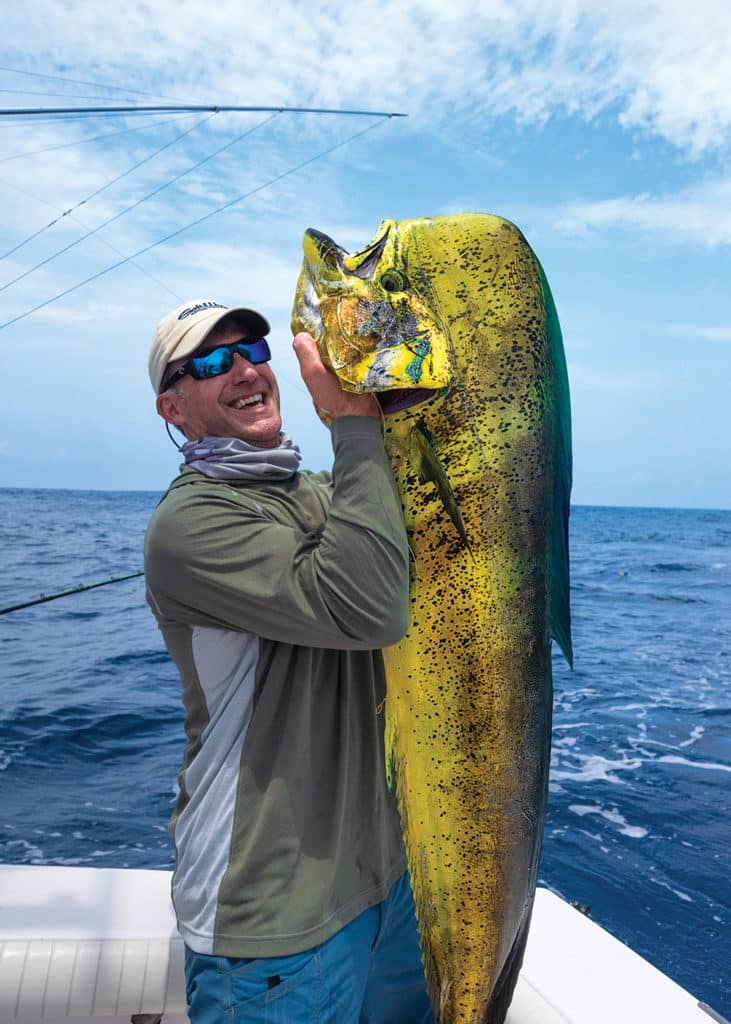
A subtle boil alongside a weed patch caught Carl Grassi’s eye. He pitched a live goggle-eye but set the hook a bit too soon. A little more patient on the recast, Grassi gave the fish time to consume the bait before reeling tight. What transpired next surprised all of us.
Instead of a 10-pounder taking to the air, a huge bull dolphin began greyhounding across the slick Gulf Stream. Blasts of white water occasionally interspersed with sargassum accented its tail walks and leaps.
We gave chase to expose the least amount of 20-pound line to the heavy floating weed concentrations. Though much tougher on the angler, we were thrilled when the big bull sounded, far from the weeds. Yet nothing compared to the jubilance after we gaffed and boated the 45-pounder.
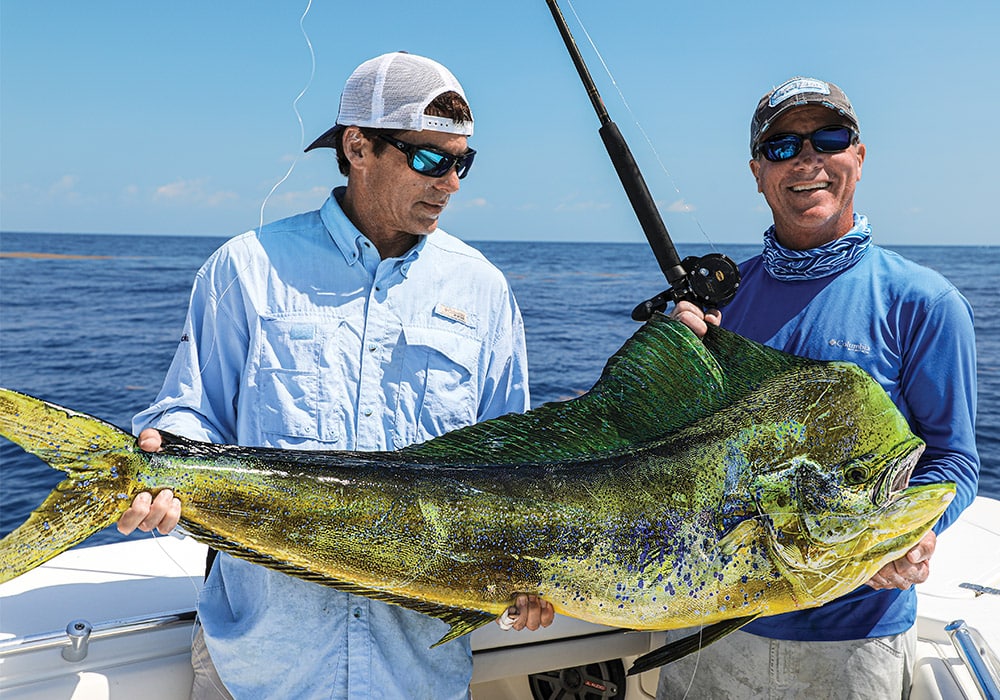
Here Fishy, Fishy
Grassi, Terry Flora and I had been running-and-gunning unsuccessfully for dolphin some 20 miles off Miami’s Haulover Inlet.
Weeds were problematic; they were everywhere. After fan-casting chuggers and pitching live baits along weed patches most of the morning, I decided to make the dolphin find us, using an old trick. It involves drifting and deploying a can’t-miss spread of baits. You basically attract dolphin by becoming a floating object and sweetening the waters with chunks of ballyhoo, Spanish sardines or pilchards. It’s a fuel-efficient way to score—all while sitting around, conversing with friends, and enjoying some tunes.
Yet there are secrets to catch the big ones.
Tricks of the Drift
After shutting down sideways near a large weed mat, bridle a goggle-eye to a 7/0 live-bait-style hook, such as a VMC No. 9260 BN. Next, secure a balloon to the line 20 feet above the bait prior to free-lining it some 70 to 100 feet. I keep the reel’s drag lever set at halfway and the clicker on. Then place that outfit—our surface-oriented live bait—in a bow rod holder.
Positioning at least one bait deep is an effective trick for large dolphin and those reluctant to rise near the surface due to hot surface temps (typical in summer) or pressure from other boats.
So, on an identical outfit, we set a live goggle-eye around 250 feet deep with a 10-ounce sinker secured to 15 inches of 12-pound mono with a small snap swivel at its opposite end to take the bait down.
Read Next: Fly-Fishing Tips for Dolphin
The snap—left open to facilitate removing the weight when playing a fish close to the boat—hangs on one leg of the double line, right at the Bristol knot connection. Using that same rig, we often place a second deep bait around 100 feet down.
Aboard MARC VI, these outfits are mostly Penn Fathom 30LD and 40NLD2 conventional reels filled with 20-pound Sufix Superior monofilament, each with a 40-foot wind-on leader of 40-pound fluorocarbon. The wind-on leaders are always joined to the monofilament main line with a Bristol knot.
Candy Land
With live baits deployed, begin broadcasting three or four pieces of ballyhoo, pilchards, cigar minnows or Spanish sardines. Once out of sight, toss over another helping. Hopefully, dolphin will notice the chunk trail and consume their way to the source—your boat. Free-line a hooked bait chunk with the freebies; after a couple hundred feet, reel it up and free-line it again in the midst of another handful of chunks. Basically, it’s yellowtail-style fishing on a grander scale, where a hooked bait drifts at the same speed as the chunks.
Read Next: All About Dolphin
Our chunking outfits are Penn Spinfisher VI 5500 or 6500 reels with 12-pound mono, several feet of 40-pound fluorocarbon leader, and a 4/0 live-bait-style hook. Two additional outfits stand ready to capitalize on any fish that swim to the boat.
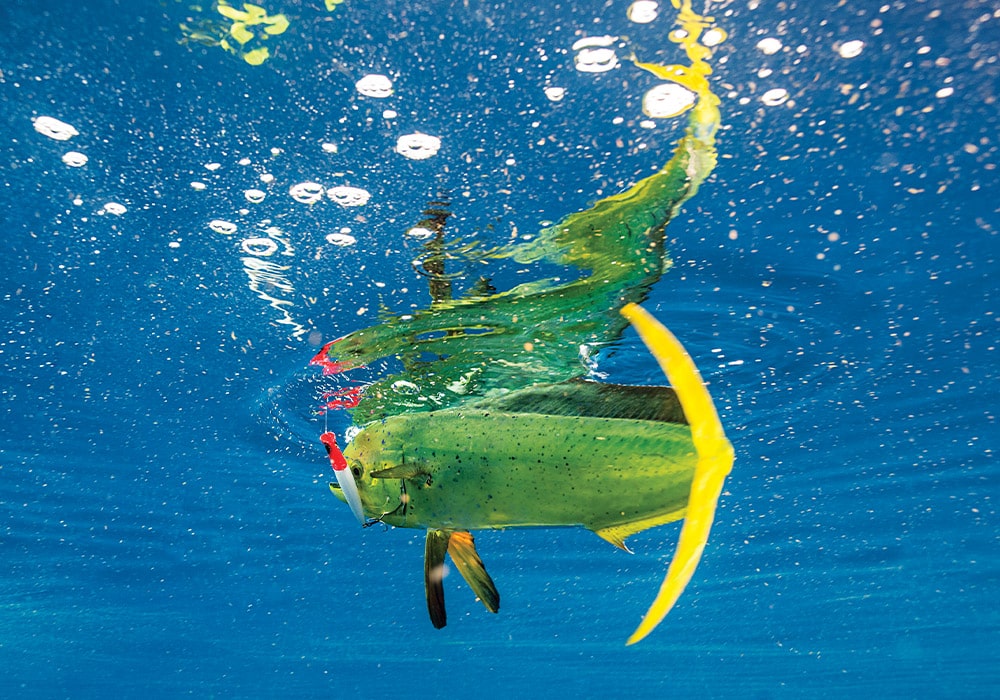
Restless Arms
It’s not all about relaxing and waiting for dolphin to show up; a little elbow grease is required. Dolphin are curious and respond well to noise. Therefore, we frequently pitch a Williamson Popper Pro 130, mostly in a Blue Sardine or Dorado color pattern, with a few feet of 50-pound fluorocarbon leader on a Penn Spinfisher VI 6500 reel spooled with 50-pound Sufix 832 braid. I believe the Blue Sardine mimics a flying fish, and the Dorado a juvenile dolphin, with the plug’s action simulating a fish that’s injured and frantically trying to escape predation; dolphin strike out of instinct. What’s more, if a fish doesn’t clobber the plug, it will follow it to the boat, within range of a pitch bait.
For large-dolphin sightings, two spinners rigged with 20-pound mono, 50-pound fluorocarbon leaders and 7/0 live-bait-style hooks stand ready within close reach, with a fresh ballyhoo, squid or live goggle-eye. This played out on a recent trip, when Don Puglisi and his family accompanied us. As we drifted along weed patches, Puglisi saw a fish swim by the bow, pitched a bait to it, and landed a beauty. Such opportunities present themselves quickly, so be ready.
Secret Discussed By Few
Drifting in this fashion is excellent for trophy dolphin. While goggle-eyes, blue runners or mullet are readily devoured by big dolphin, larger baits like schoolie dolphin are even more enticing.
Insatiable dolphin often consume their young. The 45-pounder we caught had one in its stomach, and I cleaned two others last year that had also ingested juveniles. Two seasons ago, with CCA Florida trip winner Corinne North Fuller, a large dolphin appeared and tried to eat a schoolie being reeled near the boat. Fuller pitched out a ballyhoo, and after a long, challenging fight on 12-pound spinning tackle, she landed the beautiful 36-pounder.
Read Next: Dolphin-Fishing Tips from the Pros
Our double-duty outfit is a Penn International 50 with 50-pound mono, 200-pound fluoro leader and a 10/0 circle hook. Secured to the circle hook’s bend is an assist cord with a small hook from a flutter jig. Just embed the small hook into a legal-size schoolie’s upper jaw, let it swim out about 100 feet, engage the clicker, and set the drag light so a larger dolphin or a blue marlin can move off with the bait. Then forget about this outfit and keep fishing. The circle hook on the double-duty rig prevents hooking marlin in the throat or stomach, boosting the survival odds upon its release.
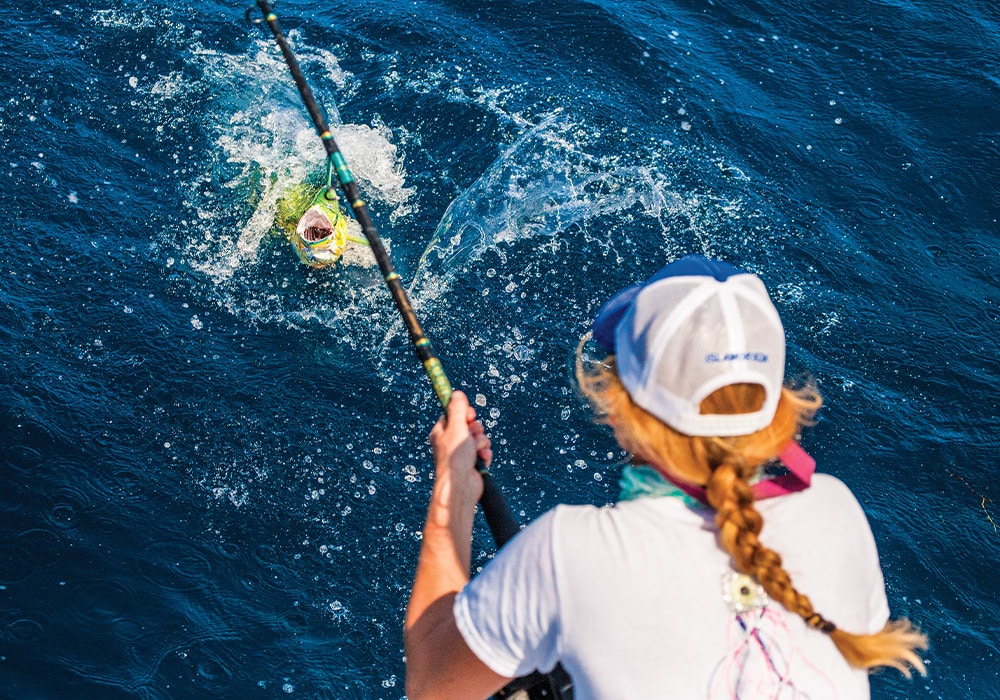
Assembly-Line Appearances
The outing with the 45-pounder was textbook perfect. The drifting tactic, uneventful for the first hour, ultimately drew in undersize schoolies for some fun catch-and-release fishing. About 30 minutes later, we iced down fish from a couple of pushes of larger school dolphin, followed shortly thereafter by the big one. We had ’em coming our way. But we had enough dolphin to clean and eat, so rather than keep at it, we stowed our gear and headed for the barn.
Keep Your Cool
Patience is a virtue with this technique. Remember, you’re becoming a floating object, sweetening the water with chunks, setting baits shallow and deep, and frequently working a chugger. Sometimes action comes quickly. But don’t become discouraged and leave if it doesn’t. Stay at it for a few hours, at least. If you do, chances are at day’s end, both your fish box and fuel tank will be a lot heavier for the effort.
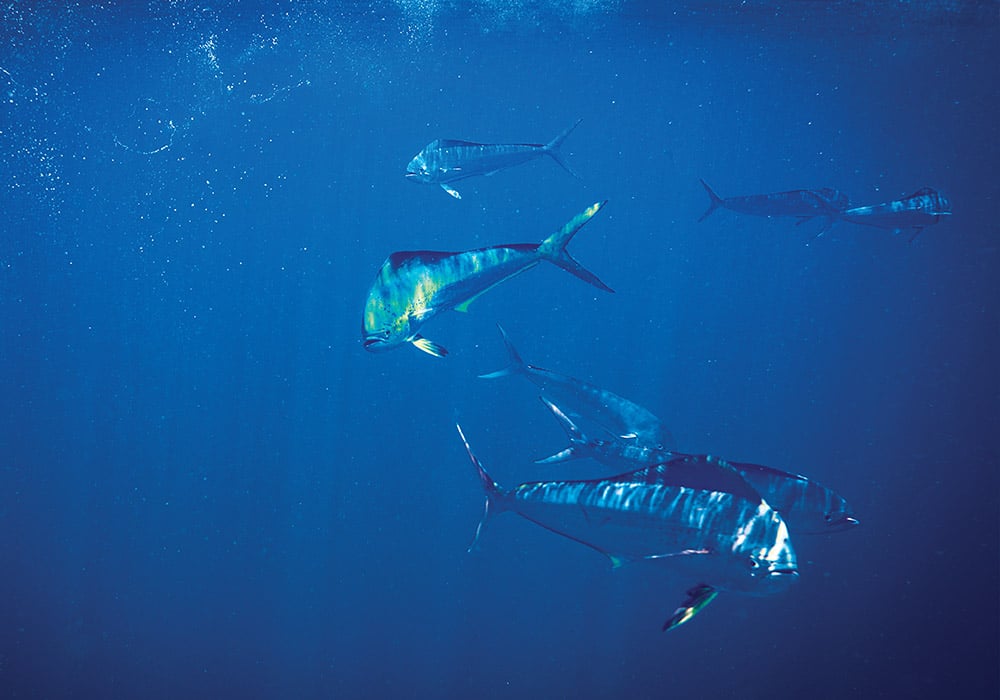
Dolphinfish Research Program
Anyone with a passion for dolphin fishing should follow the Dolphinfish Research Program. Originally started in 2002 by Don Hammond with the South Carolina Department of Natural Resources, and now under the leadership of Wessley Merten, Ph.D., the organization has blossomed into a major study on the species’ migratory habits and growth rates, via tagging. Since its inception, more than 5,000 anglers have tagged over 25,000 dolphin, which, in turn, has generated more than 625 movements. In addition, 34 satellite tags have been deployed. The goal for 2019 is to tag 3,000 small, healthy dolphin throughout the Caribbean, Gulf of Mexico, Florida Straits, mid-Atlantic and the Northeast. Tagging kits are free. For more information and tagging kits: beyondourshores.org; dolphintagging.com; 787-436-8300; wess@beyondourshores.org.
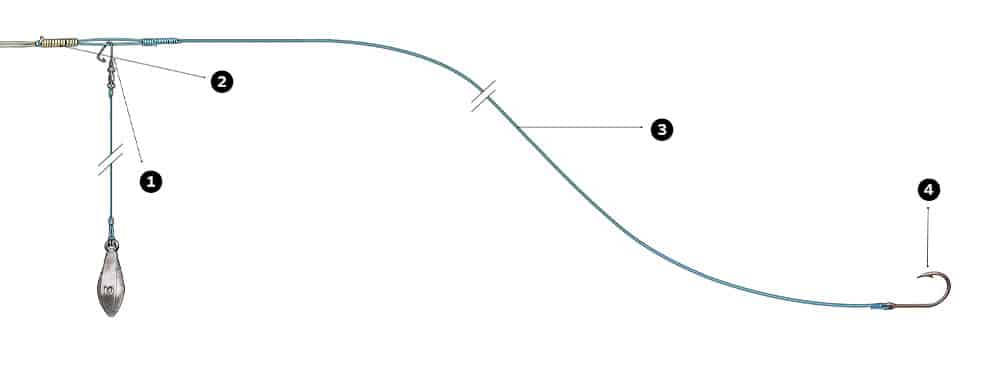
2. Double line to Bristol knot connection
3. 40 feet of 40-pound fluorocarbon
4. 4/0 to 7/0 live-bait hook Steve Sanford
Removable Sinker Rig
In order to drop a live bait and the entire leader to the desired depth, clip a sinker to one leg of the double line joining the main line to the leader. With a snap swivel left open, the sinker may be easily removed just before it reaches the rod tip, enabling the leader to be wound through the rod guides.
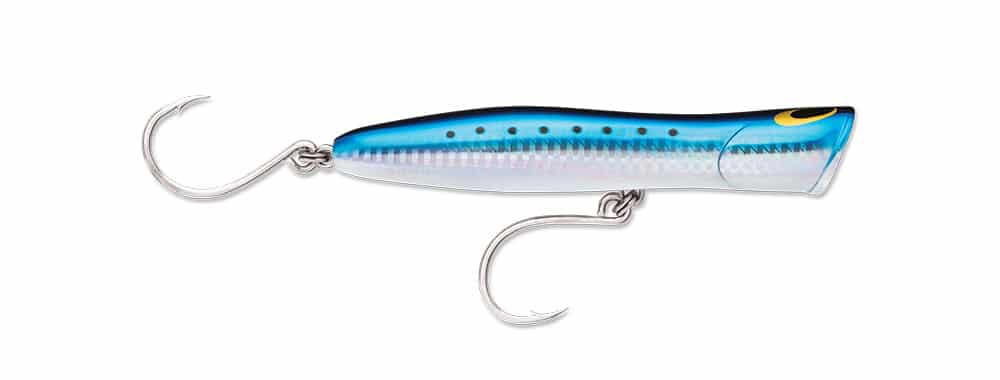
Loud pops, lifelike color schemes and strong single hooks make this a top lure choice for mahi. SWS File
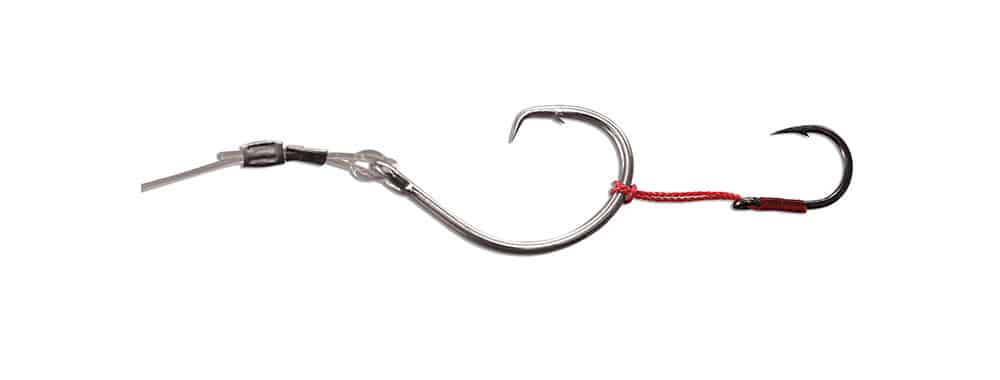
Free-line a schoolie with the small J hook in its jaw, leaving the circle hook exposed to catch any attackers. SWS File
Multifaceted Spread
Deploying live baits, chunks and artificials at once is an effective way to quickly drum up action.









